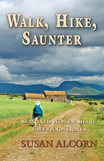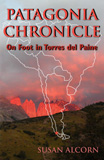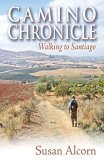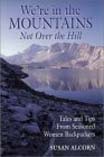
Help support this site by using our Amazon or Six Moons Design buttons for any purchase
What we do for backpacking food - freeze dried food, jerky, hardtack, powdered drinks.
Repackage: Our supper is freeze dried food. We always repackage the freeze-dried into quart ziplocks; first to be able to get more meals into the bear container, and second, to have less trash to pack out. We can put 3 or 4 of these in a gallon ziplock. We also did this for jerky and dried fruit. Now for fruit we switched to freeze dried daily packages. The original brand cut the serving size,wee need at least 20 grams for a snack. An equivalent is Brothers 7 Variety freeze dried fruit . Pricey, but good. The bags are a little puffy, so at last minute we puncture them with a pin, and scotch tape over the pin hole. Same thing for jerky if I don't repackage it. We use Tang and Wylers Lemonade. Ziplocks are a problem for powdered drinks. Powder clogs the ziplock after a few meals. One trip I used plastic sandwich bag with twist tie inside another one (suggested by a BackpackingLight group member). Most recently we use snack sized ziplocks to make 2 liters each day, 1 liter per person. We also carry Nuuns tablets for electrolytes. Powdered drinks are one of the heaviest food items we carry. A note on repackaging jerky: one year we repackaged it and put it in a resupply box that wasn't picked up for about a month. When we picked it up, some of the jerky was moldy.
My Blog entry on repackaging food
http://timecheck00.blogspot.com/2008/07/repackaging-backpacking-food-our-menu.html
Stoves and water & fuel use:
Both breakfast and supper we boil 1 1/2 liters of water for food, beverages and cleanup. We have used a MSR Whisperlite ![]() with white gas and .9 L titanium pot
with white gas and .9 L titanium pot ![]() , but now use a Gigapower canister stove
, but now use a Gigapower canister stove ![]() for summer trips. We still use the MSR for snow camping. We fill it up, boil, scoop out enough for the freeze dried meal or tea & coffee in am, and top it off with more water. As soon as that boils, it goes in the cozy for later beverages and cleanup. The freeze dried meal is in the next size down of titanium pot, and it goes into its cozy as soon as water is added. We use 4 oz of white gas per day to boil this amt of water for the two of us, so 2 oz per person per day of white gas. In 8 days we go thru a 32 oz container. The Giga Power canisters are slightly more efficient. You can save weight by using an alcohol stove. A good alcohol stove site as well as pot cozies: www.antigravitygear.com. $12 for a 0.4-ounce stove with windscreen and a tiny cup for measuring the alcohol. There is a stove called the Penny Alcohol
Stove that I made for our 110 mile PCT section A hike. That stove used 2 oz to boil .9 liters, so about the same as the MSR, but MSR would simmer for a while, so I think gas is a more efficient fuel. Re resupply boxes and fuel. It's best to buy at resupply point. Fuels can't be flown. US Postal Service will allow butane/propane canisters and alcohol to be mailed ground only provided they are packed and labeled properly. See our PCT page writeup on this: backpack45.com/pct.html#shipping-fuel .
for summer trips. We still use the MSR for snow camping. We fill it up, boil, scoop out enough for the freeze dried meal or tea & coffee in am, and top it off with more water. As soon as that boils, it goes in the cozy for later beverages and cleanup. The freeze dried meal is in the next size down of titanium pot, and it goes into its cozy as soon as water is added. We use 4 oz of white gas per day to boil this amt of water for the two of us, so 2 oz per person per day of white gas. In 8 days we go thru a 32 oz container. The Giga Power canisters are slightly more efficient. You can save weight by using an alcohol stove. A good alcohol stove site as well as pot cozies: www.antigravitygear.com. $12 for a 0.4-ounce stove with windscreen and a tiny cup for measuring the alcohol. There is a stove called the Penny Alcohol
Stove that I made for our 110 mile PCT section A hike. That stove used 2 oz to boil .9 liters, so about the same as the MSR, but MSR would simmer for a while, so I think gas is a more efficient fuel. Re resupply boxes and fuel. It's best to buy at resupply point. Fuels can't be flown. US Postal Service will allow butane/propane canisters and alcohol to be mailed ground only provided they are packed and labeled properly. See our PCT page writeup on this: backpack45.com/pct.html#shipping-fuel .
Water Filters and Purification:
We have used the Katadyn Hiker Pro ![]() filter, Katadyn Micropur
filter, Katadyn Micropur ![]() tablets and Aqua Mira drops at different times. I recommend always carrying a filter, and in addition carry either of the above purifiers. If you just carry a purifier, then you are always carrying extra water, because when you reach a water source, you can't drink it immediately. You might save a pound by leaving your filter home, but you will end up carrying more than a pound of extra water. As far as Micropur vs Aqua Mira, the Micropur tablets are easy to use, but do a liter at a time, so treating a liter and a half container is a problem (you don't want to handle the tablets). At this point I thing the Aqua Mira drops are a better choice. If you have large volumes of water to treat, such as in the desert, pumping it all is a lot of work, so pump enough to drink till the rest is purified. For a while we used the ULA gravity filter which uses the Katadyn Hiker filter element, but you just hang it instead of pumping. A little slower than pumping, and you have to be careful about cross contamination. Currently the Sawyer Squeeze Filter is a better choice even as a gravity filter.
tablets and Aqua Mira drops at different times. I recommend always carrying a filter, and in addition carry either of the above purifiers. If you just carry a purifier, then you are always carrying extra water, because when you reach a water source, you can't drink it immediately. You might save a pound by leaving your filter home, but you will end up carrying more than a pound of extra water. As far as Micropur vs Aqua Mira, the Micropur tablets are easy to use, but do a liter at a time, so treating a liter and a half container is a problem (you don't want to handle the tablets). At this point I thing the Aqua Mira drops are a better choice. If you have large volumes of water to treat, such as in the desert, pumping it all is a lot of work, so pump enough to drink till the rest is purified. For a while we used the ULA gravity filter which uses the Katadyn Hiker filter element, but you just hang it instead of pumping. A little slower than pumping, and you have to be careful about cross contamination. Currently the Sawyer Squeeze Filter is a better choice even as a gravity filter.
At the moment we are using the Sawyer Squeeze Filter. ![]() So far, so good. from REI. Important! On any flexible water container such as the Sawyer or Platypus, when submerged, it collapses, so hard to fill, and for tiny water sources hard to fill, so I carry the bottom half of a 1 liter plastic Coke bottle to use as a glass for filling flexible container when needed.
So far, so good. from REI. Important! On any flexible water container such as the Sawyer or Platypus, when submerged, it collapses, so hard to fill, and for tiny water sources hard to fill, so I carry the bottom half of a 1 liter plastic Coke bottle to use as a glass for filling flexible container when needed.
2021. We just got two Sawyer one gallon flexible containers for the gravity filter system. You also need 4 or 5 feet of hose to run from the gallon container to the squeeze filter element. The higher you can hang the source water above the filter the better. As part of the Sawyer gravity filter system, you need their hose adaptor kit.
Pot Cozies:
The pot cozies are essential to keep the food and water hot so that you only use the stove once per meal. You can buy them at www.antigravitygear.com, or you can make your own from Reflectix insulation that you buy at your building supply store. For a pattern see http://www.advancedmountainproducts.com/products/cozy/howto/kit.html
Calories:
Try for 100 calories per ounce. We've followed the backpacking food menu below with no problems or lack of energy for trips of up to four weeks. Our pound per person per day of food works out to about 1600 calories per day. We are burning about 4000+ calories per day. It is a good two or three week diet, but for a longer trip, calculate it out more carefully, including what you eat at a drop box point such as Vermillion Resort on the John Muir Trail. We hike about 12 to 17 miles per day. If you do more, you will need more calories. Note: Macadamia nuts are about 200 calories per oz. Put some in your gorp. Lucian Hicks put out a useful list of commonly available foods and calories per ounce in backcountry.net. See our detailed backpack food spreadsheet at the bottom of this page. If you want to download it to Excel, it is a google spreadsheet and the link follows the spreadsheet.
Breakfast:
Per person: tea bag or coffee (instant or bags), We used to up 2 liters of Tang for the two of us, to drink thru-out the day. We premixed it in daily bags, and also added the electrolytes to it (see further in page).We now use a variety of electolyte mixes instead. Oatmeal - instant or regular with hot water poured on it and maybe stuff added such as nuts, seeds, raisins, etc. Vitamins - one each C, multivitamin and Glucosamine. On the cereal 1/4 cup of Milkman. We used to have freeze dried no cook eggs every 4th day, but don't like them any more. It takes two packages of instant oatmeal to satisfy one person. Make one package the regular, and one the flavored to not get too nauseated by the flavor by trip end.
Between meals:
Gorp bought or homemade - M&Ms, salted nuts, raisins - 1 ounce per person per day - we are cutting back on this - very heavy, and usually have some left at end of trip. We do now carry PopTarts - one wafer for am break, one for pm break. Over the course of the day, we each go thru one Brothers 7 Variety freeze dried fruit package. The time we have it varies, but we consider the freeze dried fruit a big improvement over dried fruit, both in flavor and weight.
Lunch:
Per person, a couple of pieces of jerky, a Kudos or cereal bar, we share a freeze dried fruit package, one substantial pilot biscuit, or hardtack, garlic bagel chips, or other cracker equivalent. We can't find the big heavy pilot biscuits anymore, so looking for substitutes. Hardtack is excellent, but the batch I made one year had some mold on the ones in the drop boxes that were more than three weeks old. 1st couple of weeks were fine, and about 1/3 of the rest had green spots. One and some Tang. We made up 2 liters at breakfast. On cracker substitutes, we vary from potato chips in a can, to those little 2 oz peanut butter & cheese cracker snacks, etc.
Supper:
A two person freeze dried food meal, tea, some Tang if any left. freeze dried meal is repackaged into paper lunch bags or quart ziplocks to save space in bear container. We just replace the outer foil package, write meal name and directions on bottom of lunch bag. Cut off top of lunch bag, masking tape to seal. Most recently we've been using the supermarket plastic bags that go with a small electric vacuum pump. We find that the pasta based freeze dried dinners are more filling than the rice based dinners.
Electrolytes - Rehydration Homemade drink:
We have stopped making our own. It is simpler for us to use the Nuun tablets or similar.
Maximum Food in a Bear Canister
If you have to use a bear canister, the absolute maximum amount anyone has crammed into a Garcia canister is 8 days for two people. This was done by Ken and Marcia Powers, who have thruhiked the pct, at, cdt, adt and more: 16 days of food in a Garcia..
Thru-hikers need a lot more calories and prefer a menu that they can resupply from trail town stores.
This is a thru-hiker menu that Mike & Kam Watkins shared on CDT-L:
Breakfast - old fashioned oats with powdered milk and instant pudding mix. For variety use grape nuts, granola or similar.
Lunch (twice a day) - whole wheat tortillas with peanut butter, honey and granola on them - or crackers, bagels, cream cheese. Sometimes energy bars, fig newtons, nuts and raisins. Also snack mix - granola, cereal, pretzel mix or "corn-shew mix" - crushed corn tortilla chips, corn nuts and cashews - vary the flavors.
Dinners - pasta meals, quick cook rice meals, mac & cheese, couscous and ramen noodles - always add instant mashed potatoes to bulk up dinners.
Dessert - No-bake cheesecakes 1st choice. Pudding, jelly-bellys, grandma cookies alternatives.
Thru-hiker.com Food Article:
This site has an excellent series of articles by Brenda Braaten, a PhD nutritionist. I particularly recommend recipes, extreme conditions and trail snacks: http://www.thru-hiker.com/articles.asp?subcat=12&cid=39
In JMT drop boxes besides backpacking food:
Toilet paper, maps, flashlight and batteries, buy fuel at drop point
Hardtack Recipe:
I think this is the hardtack recipe that I used, just searched the web again and found it in a Trailwise posting:
3 cups all-purpose flour 1 cup whole wheat flour 1/2 cup yellow cornmeal 1/2` cup cracked wheat 1 tablespoon sugar 1 tablespoon salt 1 3/4 cups buttermilk
Combine flours, cornmeal, wheat, sugar and salt. Add buttermilk, mix well, and knead briefly. Shape dough into golf-ball-sized portions. Dust with flour and roll very thin. Place on greased and floured baking sheet. Bake at 400 degrees, turning several times, until lightly browned on both sides. Cool; then store in waterproof container. Keep from moisture. This makes about twenty four 3 1/2 inch crackers. My last batch took about 24 minutes, turning 4 times for each of the two oven loads.
Backpacking Food Books or items:
One Pan Wonders by Teresa "Dicentra" Black This Triple Crown Hiker's tried and true backpacking simple meals
This is our food spreadsheet:
Emma Gatewood first hiked the entire 2160 mile Appalachian Trail at the age of 67. She last hiked it at the age of 76.
Page Changed: February 1, 2020 16:20
[Home][Top of Page] -
Please send comments, suggestions to backpack45 circleatsign yahoo dot com
All
text and images copyright © Shepherd Canyon Books - 2003 through 2020
“backpack45.com is a participant in the Amazon Services LLC Associates Program, an
affiliate advertising program designed to provide a means for sites to earn
advertising fees by advertising and linking to amazon.com”




